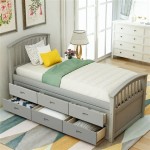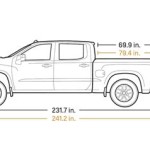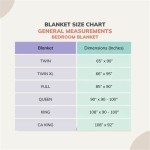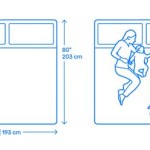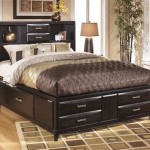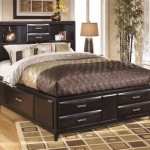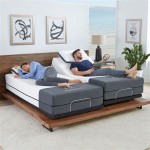Memory Foam Topper King Size Bed: Enhancing Sleep Quality and Comfort
A memory foam topper for a king size bed represents a significant investment in sleep hygiene and overall well-being. These toppers, designed to conform to the body's shape, offer a unique combination of support and pressure relief, potentially mitigating discomfort and promoting restorative sleep. The king size dimension, specifically, caters to couples or individuals who desire ample space and freedom of movement during the night. Understanding the nuances of memory foam composition, density, and construction is crucial for selecting a topper that effectively addresses individual sleep preferences and physical needs.
The construction of a memory foam topper primarily revolves around viscoelastic polyurethane foam, the material responsible for its characteristic conforming properties. This type of foam responds to body heat and pressure, softening and molding to the contours of the sleeper. Upon removal of pressure, the material gradually returns to its original shape, hence the term "memory foam." The density of the foam, typically measured in pounds per cubic foot (lbs/ft³), plays a critical role in determining its firmness, support, and longevity. Higher density foams tend to be more durable and provide greater support, while lower density foams may offer a softer, more plush feel but potentially at the expense of long-term performance.
Beyond density, the thickness of the topper also influences its overall feel and effectiveness. Thicker toppers, generally ranging from 3 to 4 inches, provide a more pronounced cushioning effect and can be particularly beneficial for individuals with pressure points or chronic pain. Thinner toppers, typically 2 inches or less, offer a more subtle adjustment to the mattress's firmness and are often preferred by those who simply seek to enhance comfort without significantly altering the existing support system. Factors such as body weight, sleeping position, and individual comfort preferences should be carefully considered when selecting the appropriate thickness.
Understanding Memory Foam Density and Firmness
The terms "density" and "firmness" are often used interchangeably, but they represent distinct characteristics of memory foam. Density, as previously mentioned, refers to the weight of the foam per unit volume and is a primary indicator of quality and durability. Firmness, on the other hand, describes the resistance the foam offers to compression. A high-density foam can be either firm or soft, depending on its internal cellular structure and composition. Generally, high-density foams tend to be firmer, but this is not always the case. Manufacturers often employ various techniques, such as modifying the foam's cell structure or adding softening agents, to achieve a desired firmness level independent of density.
A low-density memory foam topper (less than 3 lbs/ft³) will generally offer a softer feel and will conform more readily to the body's shape. However, these toppers may be less durable and may compress more quickly over time, potentially leading to a loss of support and comfort. They are often a more budget-friendly option and may be suitable for individuals who prefer a very plush sleeping surface or who are seeking a temporary solution. Mid-density memory foam toppers (3-5 lbs/ft³) strike a balance between comfort, support, and durability. They offer a good level of contouring while maintaining adequate resilience. This density range is often recommended for a wide range of sleepers and sleeping positions. High-density memory foam toppers (5 lbs/ft³ and above) provide the greatest support and durability. They are less likely to compress over time and are often preferred by individuals who require firm support or who have higher body weights. While they may initially feel less plush than lower-density options, they tend to provide more consistent support over the long term.
The choice of density and firmness ultimately depends on individual preferences and needs. Individuals who experience back pain or require significant spinal alignment often benefit from firmer, higher-density toppers. Side sleepers may prefer a softer, lower-density topper to alleviate pressure on their shoulders and hips. Back sleepers may find a medium-density topper to be the most comfortable option, providing adequate support without excessive contouring. Careful consideration of these factors is essential for selecting a topper that will effectively enhance sleep quality and mitigate discomfort.
Considerations for Temperature Regulation
One common concern associated with traditional memory foam is its tendency to retain heat, potentially leading to discomfort and night sweats. This phenomenon is primarily attributed to the closed-cell structure of conventional memory foam, which restricts airflow and limits the dissipation of body heat. However, advancements in material science have led to the development of various cooling technologies designed to mitigate this issue.
One strategy employed by manufacturers is the incorporation of open-cell memory foam. This type of foam features a more porous structure, allowing for increased airflow and improved heat dissipation. Open-cell memory foam is generally more breathable than traditional closed-cell foam, helping to regulate body temperature and create a more comfortable sleeping environment. Another approach involves the infusion of cooling gels or other phase-change materials into the memory foam. These materials absorb and release heat, helping to maintain a consistent temperature throughout the night. Gel-infused memory foam toppers are often marketed as "cooling" toppers and are particularly appealing to individuals who tend to sleep hot.
In addition to material modifications, some manufacturers incorporate ventilation channels into the topper's design. These channels further enhance airflow, allowing for greater heat dissipation and improved breathability. These ventilation channels, strategically placed throughout the topper's surface, create pathways for air to circulate and prevent the accumulation of heat. Furthermore, the cover material of the topper can also play a role in temperature regulation. Covers made from breathable fabrics such as bamboo, cotton, or Tencel can help to wick away moisture and promote airflow, further enhancing cooling performance. When selecting a memory foam topper, particularly for individuals who are sensitive to heat, it is essential to consider these temperature-regulating features and choose a product that effectively addresses this concern.
Evaluating Construction and Certifications
The overall construction of a memory foam topper extends beyond the composition of the memory foam itself. The manufacturing process, the quality of the materials used, and the design of the cover all contribute to the topper's performance, durability, and safety. Reputable manufacturers adhere to strict quality control standards and utilize materials that are free from harmful chemicals.
Certifications such as CertiPUR-US and OEKO-TEX Standard 100 provide assurance that the memory foam has been independently tested and certified to meet specific safety and environmental standards. CertiPUR-US certification indicates that the foam is made without ozone depleters, PBDEs, TDCPP or TCEP ("Tris") flame retardants, mercury, lead and other heavy metals, formaldehyde, and phthalates regulated by the Consumer Product Safety Commission. It also certifies that the foam has low VOC (Volatile Organic Compound) emissions for indoor air quality (less than 0.5 parts per million). OEKO-TEX Standard 100 certification ensures that the textiles and fabrics used in the topper's construction have been tested for harmful substances and are safe for human contact.
Beyond certifications, the construction of the topper's cover is also important. A well-designed cover should be breathable, durable, and easy to clean. Many toppers feature removable and washable covers, which can help to maintain hygiene and prolong the topper's lifespan. The cover material should also be resistant to allergens and dust mites, particularly for individuals with allergies or asthma. The stitching and seams of the cover should be reinforced to prevent tearing or unraveling. Examining these construction details and seeking out toppers with relevant certifications can help to ensure that the product is safe, durable, and meets the expected quality standards. Choosing a memory foam topper from a reputable manufacturer with a proven track record of quality and customer satisfaction is crucial for making a worthwhile investment in sleep comfort and well-being.

Smiaoer Gel Memory Foam Mattress Topper King Size 3 Inch For Pressure Relief Blue

Best Mattress 4 In King Cooling Gel 5 Zone Memory Foam Topper Hd 5zmf Gm4k

Stylewell 4 In Gel Infused Memory Foam California King Mattress Topper

Mainstays 3 Memory Foam Mattress Topper Queen

Memory Foam Mattress Topper King 3 Gel Bed Cooling W Cotton Cover Serta

Mellow 4 Cooling Gel Egg Crate Memory Foam Mattress Topper King

Tuft Needle Heather Gray 2 In Memory Foam King Mattress Topper

Lucid Comfort Collection 3 Inch Gel And Aloe Infused Memory Foam Topper King Hdlu30kk30gt The Home

Beddle Mattress Topper 3 Inch King Size Gel Memory Foam Bed Pressure Relief For Back Pain

1 5 Memory Foam Mattress Topper King At Home

